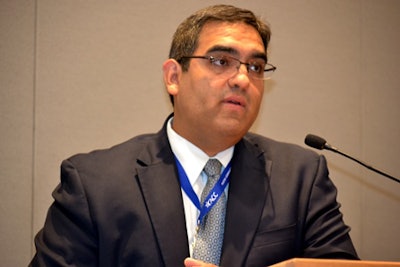 Victor Saenz, associate professor of education at the University of Texas Austin, discusses Latino males at community colleges at NISOD.
Victor Saenz, associate professor of education at the University of Texas Austin, discusses Latino males at community colleges at NISOD.On Tuesday morning, Diverse will present Dr. Walter Bumphus, president of the American Association of Community Colleges, with the Diverse Champions Award via satellite at the National Institute for Staff & Organizational Development’s (NISOD) 35th annual International Conference on Teaching and Leadership Excellence in Austin, Texas. This is the second time Bumphus will receive the award. He was originally presented with the award in April at the AACC conference held in San Francisco, Calif.
“The Champions Award is looking at community college leaders who have a commitment to diversity,” said David Pluviose, executive editor of Diverse. “For me, it’s exciting because it gives an opportunity for us at Diverse to recognize the exceptional work of community colleges in helping first-generation minority students — giving them a chance that no one else will give them.”
NISOD is the outreach arm of the Community College Leadership Program (CCLP) at the University of Texas at Austin. It provides professional development opportunities and experiences to community and technical college faculty, staff and administrators.
It was fitting that Bumphus was recognized for his commitment to diversity and equal opportunity during the NISOD conference, an event at which issues of access and inclusion loomed large. For example, a session Monday morning, titled, “Promoting an Inclusive Environment for all Students,” explored the use of new technologies to empower community college students with physical and cognitive disabilities.
“When I joined Dell, we looked at what we were going to do to provide accommodations for accessible technologies, and our first focus point was really about education,” said Kelli Hodges, a business development manager for Dell, who led the discussion. “We all use different types of tools and resources that empower us in our daily jobs, and technology can be a bridge, an avenue.”
Pluviose participated in a panel discussion that explored the media’s portrayal of two-year schools and how those schools can effectively challenge the most widely held misperceptions about community colleges. Pluviose was joined on the panel by Roy Jenkins, associate professor of English at Georgia Perimeter College; Larry Jacobs, president of Higher Education Talk Radio; and Andrea Hanstein, a public information officer at Fullerton College in California.
There was a consensus among the panelists that community colleges must devise communication strategies that trumpet their comparability with four-year institutions while not losing sight of what makes them unique.
Another session explored the plight of Latino males at community colleges. Victor Saenz, an associate professor of education at the University of Texas Austin, offered some of the most recent research into the distinct challenges faced by this group of students.
“In Texas, we know that one out of every two public school students is Hispanic, and ultimately, as we look at the future of the educational pipeline, that pool is going to venture into higher education as well,” said Saenz. “We know that 75 to 80 percent of Hispanics begin higher education at the community college level here in Texas. That provides a great deal of impetus for us to focus on that sector.”
The NISOD conference concludes tomorrow.





















